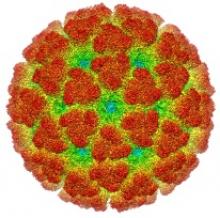
General Description
Chikungunya (chik-en-gun-ye) virus is a small (about 60-70 nm diameter), spherical, enveloped virus. Chikungunya disease is caused by the chikungunya virus (CHIKV), an arthropod-borne virus, which means it is transmitted by arthropods, such as mosquitoes and ticks that are also known to cause other illnesses such as encephalitis, yellow fever, and dengue. It is a member of the Alphavirus genus in the Togaviridae family. The CHIKV is mainly spread from person to person through mosquitoes. The name comes from an African word, and it translates to ‘that which bends up,’ because people bend up with joint pain, one of the most common symptoms.
Scientists believe the virus originated in 1952 in southern Tanzania. Chimpanzees or other animals were probably infected first. Mosquitoes that bit these animals became infected, then bit and infected people. The virus can stay in a person’s system for about a week. When a mosquito feeds on an infected person, the mosquito can become infected and can then bite and infect others.
Significance
In the past decades, outbreaks have occurred in Africa, Asia, Europe, and the Indian and Pacific Oceans. The virus was found for the first time in the Americas on Caribbean islands in late 2013. More than 20 Caribbean and South American countries and territories have reported outbreaks, according to the CDC. On July 17, 2014, the CDC reported the first locally transmitted case of chikungunya in Florida, in a male who hadn’t traveled outside the United States. Areas close to the United States and Canada have reported cases, Puerto Rico has 121 locally transmitted cases, and the U.S. Virgin Islands have had two cases. Over 5,000 cases were reported in the Caribbean (as of November 2014), and 21 deaths have been confirmed.
Symptoms
The most common symptoms of chikungunya virus infection are fever and joint pain. Headache, muscle pain, rash and joint swelling can also occur. When the person first becomes sick, they may believe they have a flu-like illness. Symptoms usually appear 4-7 days after the mosquito bite. About 90% of those bitten will develop symptoms. The disease is rarely fatal, although, in older people, the disease can contribute to the cause of death. Most patients recover in about a week, and only a few require hospitalization. A small number develop joint pain that lasts for months. Newborns exposed during delivery, people 65 and older, and people with medical conditions such as diabetes, or heart disease are particularly vulnerable to infection and complications.
Transmission
The virus is transmitted to people through mosquito bites. Mosquitos acquire the virus when they feed on persons who are infected with the virus. Two types of mosquitoes, the Aedes aegypti, and Aedes albopictus, who mainly bite in the daytime, are tied to the transmission of chikungunya. These same species also transmit dengue fever. There is the possibility that transmission could also happen
There is the possibility that transmission could also happen between mother and child near the time of birth or through a blood transfusion although there are no known reports of this happening.
Treatment
There is no medicine to treat chikungunya. The typical treatment includes action to decrease the symptoms.
- Rest
- Fluids to prevent dehydration
- Pain medications, such as ibuprofen, naproxen, acetaminophen, or paracetamol, to relieve fever and pain.
Prevention
Currently, there is no vaccine available to prevent chikungunya infection or disease. Although the virus is rare in the North America, travelers to endemic countries such as the Caribbean should take precautions against mosquito bites. The best way to prevent chikungunya is by avoiding mosquito bites. The mosquitoes that spread chikungunya bite mostly during the day time. To avoid mosquito bites travelers should do the following:
- Cover up exposed skin by wearing long-sleeve shirts, long pants, and hats
- Use insect repellant that contains DEET, picaridin, oil of lemon eucalyptus, para-methanethiol (PMD), or IR3535.
- Consider treating clothing and tent with the insect repellent
- Stay and sleep in rooms with screens or air-conditioning
- Use bed nets if you are sleeping outdoors.
Cleaning and Disinfection
See table of recommended disinfectants in the PDF link below.

